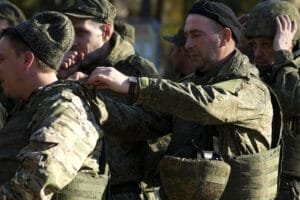There’s a new and potentially very significant factor in the Ukrainian conflict: the Ukrainians’ ability to use recently supplied Western systems to hit Russian command posts, logistical hubs and ammunition dumps a long way beyond the front lines.
In the past week, there have been enormous explosions in several occupied areas in the Donetsk, Luhansk, Zaporizhzhia and Kherson regions. The available evidence, from satellite imagery and Western analysts, is that the targeting has been highly effective.
For months the Ukrainian military pleaded for long-range precision artillery and rocket systems from Western partners. Now they have them and are deploying them to considerable effect in both the south and east of the country.
The Ukrainian military is not giving away many specifics but Vadim Denysenko, a senior official at the Interior Ministry, said Wednesday that in the past two weeks, “above all things thanks to the weapons that Ukraine received, we were able to destroy approximately two dozen warehouses with weapons and stocks of fuel and lubricants. This will certainly affect the intensity of fire” the Russians can muster, he said.
Best-in-class is the US-supplied HIMARS multiple launch rocket system, but the Ukrainians have also received M777 howitzers from both the US and Canada, and Caesar long-range howitzers from France.
In addition, the UK has committed to providing M270 Multiple Launch Rocket Systems (MLRS), which are more powerful than HIMARS, but it’s unclear when Ukraine will complete training on the system and deploy it.
The HIMARS’ versatility is in its name: the High Mobility Artillery Rocket System. Its mobility makes it harder to target and it can be crewed by just eight soldiers. The rockets supplied to Ukraine have a range of 70 to 80 kilometers (about 50 miles). And their GPS guidance systems make them extremely accurate.
As Mick Ryan, a military analyst and former Australian major-general, puts it: “It is used to destroy critical communications nodes, command posts, airfields, and important logistics facilities.”
Senior Russian officers are therefore especially vulnerable. HIMARS’ accuracy also means the Ukrainians can worry less about civilian casualties. The guided rockets are accurate to within two to three meters, two defense officials told CNN, allowing the Ukrainians to use far fewer rounds to hit targets precisely at distance.
The HIMARS appears to have been used in a massive strike against a warehouse in the town of Nova Kakhovka in the Kherson region on Monday night. The strike set off secondary explosions and caused widespread damage, according to satellite imagery reviewed by CNN. The imagery showed how precise the attack had been, leaving just one small crater.

Local pro-Russian officials said parts of one HIMARS rockets were recovered; the serial numbers matched the weapon.
There were also large explosions in the Luhansk and Donetsk regions, setting off multiple detonations. The same happened at Shakhtarsk in Donetsk and in the Kherson region at the weekend, as well as near Melitopol in Zaporizhzhia last week.
Altogether, it appears that about a dozen targets deep behind Russian lines have been hit in July, most of them at least 40 kilometers behind the front – a distance at which accuracy with old Tochka-U missiles would be difficult.
The Ukrainians have also been firing HIMARS at night, making it more difficult for the Russians to spot and strike the launchers. Russian forces have struggled to fight at night since the beginning of the conflict, and the Ukrainians are still using this to their advantage.
Changing the battlefield
Targeting may also have been made easier by the way the Russian military stores and moves its weapons.
Phillips O’Brien, professor strategic studies at St Andrews University, says the Nova Kakhovka strike is revealing “about the state of the logistics war and the real problems the Russians face.”
The target was adjacent to a rail hub, vital to the Russian logistics effort to sustain their offensive, and so was an obvious target.
“The Russians left a ludicrously easy to locate, major supply depot exactly where someone would expect to find it. Either the Russians are unable to react because of command failure or they can’t actually move the depots because they lack the road movement,” O’Brien tweeted.
One Ukrainian official hinted that targeting the warehouse had been easy. Serhiy Khlan, a member of Kherson regional council, said on Facebook: “In Nova Kakhovka minus one Russian ammo depot. They brought, brought, stockpiled, stockpiled and now have fireworks at night.”
Ben Hodges, the former commander of the US Army in Europe, tweeted after the Kherson attack at the weekend: “Least favorite job in the Russian Army? Ammunition handler.”
In a briefing last week, a senior US Defense Department official said that “the focus on higher capability, precision, further-range weapons” for Ukraine was front and center.
On Friday, the Pentagon announced a shipment to Ukraine of 1,000 rounds of 155mm artillery shells – but a newer munition with greater accuracy, according to the official. The Ukrainians have been expending 155mm munitions at a rate of 3,000 a day. Like HIMARS, the more accurate rounds should mean fewer are needed.
The official contended that HIMARS was changing the battlefield. “What we’ve seen is the ability of the Ukrainians to use these HIMAR systems to significantly disrupt the ability of the Russians to move forward.”
“If the Russians think they can outlast the Ukrainians, they need to rethink that,” the official added.


A Russian military reporter, Yuri Kotenok, said this week that the HIMARS represents “a serious threat. The liberated areas of the Kherson and Zaporizhzhia regions, the DPR and the LPR, as well as the territory of Russia, fall under the possible fire of HIMARS.”
Kotenok, who has nearly 300,000 followers on Telegram, said Russian air defenses need to be improved – as does the targeting of HIMARS, whether in transit or deployed. He said that “If this continues, it is necessary to hit the decision-making centers. Our limitations in retaliatory strikes against the enemy are to some extent incomprehensible to me.”
Another Russian reporter, Roman Sapenkov, said he witnessed the strike at the weekend on the Russian base at Kherson’s airport.
“I was struck by the fact that the whole packet, five or six rockets, landed practically on a penny. Usually MLRS lands in a wide area, and at maximum range they scatter like a fan,” he wrote, referring to multiple launch rocket systems that are less advanced than HIMARS or the M777.
“It is clear this is just the beginning … They will cover all the command posts and military facilities; the data for this has been collected for the last 4 months.”
The importance of pallets
One problem for the Russians may be the way they transport munitions, which is where the humble pallet comes into play.
Few Russian military trucks include a crane to lift heavy munitions, which are rarely carried on pallets but loaded and unloaded by hand. Plenty of ageing Soviet ZIL trucks have been seen in Ukraine.
Moving weapons and ammunition this way is cumbersome, time-consuming and potentially gives enemy surveillance a greater opportunity to detect such shipments. By contrast, the UK and US militaries palletize much of their ammunition or carry it in containers.
The Russian way of war – as witnessed over the last three months in eastern Ukraine – relies on huge artillery barrages to pulverize targets before moving forward. Russian military doctrine has always emphasized a massive use of artillery, MLRS and mortars. That demands constant resupply: Some analysts calculate that Russia is using at least 7,000 shells and rockets a day in Donbas, and often many more.
Serhiy Hayday, head of the Luhansk regional military administration, said Wednesday: “The Russian army does not stop shelling. However, most likely, it saves the existing stocks of shells, because their supply has been interrupted by the work of our new long-range weapons.”
Ukrainian officials claim that the Russians are being thrown off-balance by their growing capability for long-range precision attacks.
In and around Melitopol, for example, the Russians have imposed restrictions on civilian movements in recent days. The area has seen at least two major strikes this month against Russian bases.
But for the Ukrainians to sustain this rate of strikes requires an unimpeded conduit of munitions from the West. The Ukrainian military is transitioning from an organization largely reliant on Soviet-era artillery and rocket systems – with inadequate ammunition – to using precision Western weapons with enough ammunition in a matter of months.
Also unknown is whether any of the handful of HIMARS so far shipped have been taken out by Russian fire. The Ukrainian military and defense ministries avoid providing details about their deployment.
Ryan cautions that while the HIMARS “has provided the Ukrainian Armed Forces with a new ‘Long Hand’ to attack the Russian invaders, there is no such thing as a silver bullet solution in war.”
But US officials are confident that the accuracy of the weapon – as well as other accurate long-range systems – will progressively change the battlefield.
Source : CNN











Add Comment